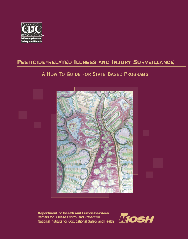Pesticide-Related Illness and Injury Surveillance: A How-To Guide For State-Based Programs
2006
DHHS (NIOSH) Publication Number 2006-102

This manual provides information on how to develop and maintain surveillance programs for acute and subacute health effects from pesticide exposure. The primary target audience is State health departments with planned or established pesticide poisoning surveillance programs. Other target audiences include agencies (e.g. local agencies, other state and federal government agencies, and international agencies), and members of the public interested in pesticide poisoning.
Pesticide poisoning is a complex condition for surveillance. It encompasses many illnesses and injuries created by single or mixed exposures to pesticide products. Pesticide products are often mixtures composed of pesticides and other ingredients that may have adverse human health impacts. The complex nature of pesticide poisoning, and technical resources needed for case investigation, warranted the development of this manual. Guidelines for surveillance program development, case investigation, data collection, outreach, and education can be found in the manual. The manual will be most useful when read in sequence − Chapter 1 through Chapter 9 and appendix G − before implementing surveillance. Additional information that will be useful both in the initial phases of developing a surveillance program and the ongoing implementation of the surveillance system is provided in the appendices. The manual is also designed to address issues of capturing pesticide-related illnesses and injuries in workplace and non‑workplace settings.
The manual (which provides the case classification scheme, severity index, and sample data collection forms in the appendices), along with the standardized variables and the SENSOR-Pesticides Incident Data Entry and Reporting (SPIDER) software, are intended to simplify and streamline the surveillance system development process. Note that many of the tools and techniques covered in this manual can be generalized for surveillance of other occupational and environmental injuries and illnesses.
2006-102.pdf [PDF - 16 MB]
- Page last reviewed: June 6, 2014
- Page last updated: June 6, 2014
- Content source:
- National Institute for Occupational Safety and Health Education and Information Division


 ShareCompartir
ShareCompartir